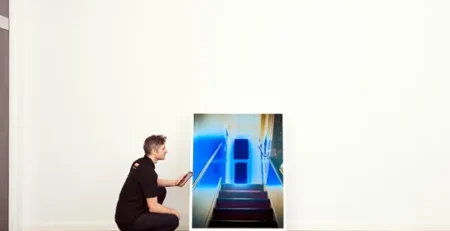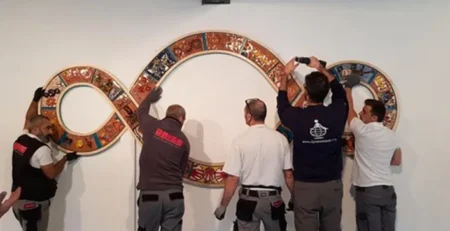Women in Art Logistics – Part II
- Company News

“It’s about time!”, said Ida Ng, CEO of Singapore-based Helutrans and recently elected Chairperson of ICEFAT, who was speaking here about the increased equal opportunities in all manner of roles in our industry. As the first-ever woman to hold the role of Chair, she is indicative of the progress being made across ICEFAT and its membership from senior administration to art handling. With this in mind, how have women working for ICEFAT members found the industry and what do they hope for its future? We have spoken to women across our membership who hold different roles, at varying levels, about the perceptions and successes of women in art logistics to date.
I. FINE ART HANDLERS

Canelle Braun of Natural Le Coultre (Switzerland)
Canelle Braun, a Fine Art Handler at Geneva-based Natural Le Coultre, believes that women bring alternative skills and perspectives that are necessary in a previously male-dominated space. For her, being part of a gender-diverse workplace has afforded a greater level of personal care from the entire team for the precious objects being handled, going far beyond the basic physical requirements and practicalities of the role:
Being convinced that art serves as a means of social reflection and is our most precious asset, I decided to apply for this job because the idea of protection seemed essential to me.
While the majority of Canelle’s colleagues are men “with a background in moving and logistics”, she brings to her work a certain “gentleness” and says that she is excited to see more women enter the industry, for the strength necessary to thrive in her role is “not just physical but also intellectual”.
Another example comes from Spain-based TTI, where Isabel Martínez Palomino speaks of the improvements to workplace culture in her time in the industry and the meritocratic, rather than gender-based, assessment of her work.
Most of these [biased] attitudes happened in my early years. Step by step these behaviours have decreased. I am nowadays in good consideration due to the quality of my work. It’s very important that managers identify the skills of each of the workers in their company and place them correctly in the most appropriate position or role.
II. MANAGERIAL
Working in management can offer the advantages of being involved in all aspects of a company’s operation, as Maria Uribe, Fine Art Logistics Manager at California-based Cooke’s Crating, reveals. She says the positives of her management position include: “training, project management, coordinating international and domestic shipments, consulting, advising our team, and working closely with Cooke’s Management.” She relishes the international aspects of her work, adding that she “loves the interactions with other logistic managers throughout the world.”

Hayley Hooper of Uovo (US)
While this is the case, US-agent UOVO’s Hayley Hooper, Account Management & International Services, notes that there are improvements to be made in workloads beyond the formal aspects of women’s roles in art logistics:
You are often given tasks in addition to your own workload that are labelled as “soft skills” as the default over male colleagues with the same skillset. This leads to a larger (and less visible) workload that you are just expected to carry as normal.
III. DIRECTORIAL

Linda Boe of Gander & White San Francisco
At the most senior levels there is still work to be done, however, as Renata Vinhas, General Manager at FINK Mobility in Brazil and ICEFAT Steering Committee Member since 2019, points out:
Breaking the glass ceiling is an ongoing challenge, with women often finding themselves underrepresented in boardrooms and executive positions. Addressing this issue involves promoting diversity and inclusion policies, mentorship programs, and initiatives that empower women to pursue leadership roles.
Renata’s company provides one example of the success of promoting diversity in the workplace with most of the managerial and directorial team being women. Similarly, Linda Boe, the Director of Gander & White San Francisco, points to the importance of employing women across all levels of the workforce, from entry-level upwards:
I currently have some fantastic women working on our trucks, and in our warehouse. They are working to learn our industry, our methods, and these are exactly the sorts of leaders we need for tomorrow in our industry. I get excited talking with them, teaching them, opening doors for them.
Isabelle Harsch, who has led ICEFAT member HARSCH in Switzerland since 2015, agrees that the success of her business relies on the championing of her female colleagues:
We recently hired our fourth female worker for the operation, and watching her work, I can tell there is no difference between her and a man […] She is one of those women who is leading the way and I am very proud of her!
Isabelle has seen an internalised perception from some women that they will not suit roles in art logistics, saying that “we can think too much and wonder more often than men if we are legitimate in our role or position”, which is echoed within the leadership of Austrian ICEFAT agent MuseumsPartner. Kathrin Sandrini, CEO of the company, sees:
The issue of self-perception: we believe that we are only taken seriously if we work at least as well as the best man. This is not true. In my environment, I have made the experience that everyone is perceived as a person first, regardless of the person’s gender.
MuseumsPartner works mainly with institutions and Kathrin has seen the most senior positions within these organisations are increasingly being filled by women, a process that is clearly happening concurrently in the fine art logistics sector. Certainly, by recognising the virtues of gender diversity in fine art logistics we will inevitably see not only a more diverse industry but also a more successful one. As Ida stated, it is about time that this progress is happening, but our work must not falter in creating a truly equitable industry.










